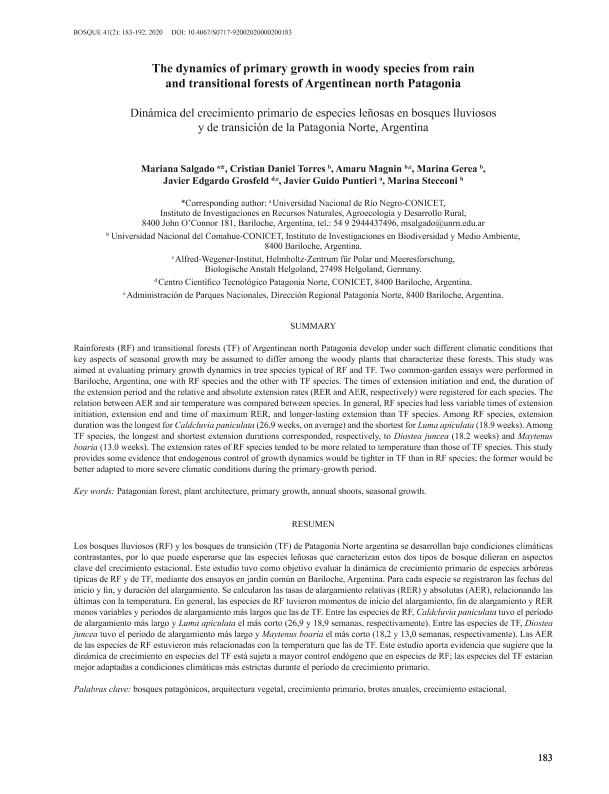Artículo
Los bosques lluviosos (RF) y los bosques de transición (TF) de Patagonia Norte argentina se desarrollan bajo condiciones climáticas contrastantes, por lo que puede esperarse que las especies leñosas que caracterizan estos dos tipos de bosque difieran en aspectos clave del crecimiento estacional. Este estudio tuvo como objetivo evaluar la dinámica de crecimiento primario de especies arbóreas típicas de RF y de TF, mediante dos ensayos en jardín común en Bariloche, Argentina. Para cada especie se registraron las fechas del inicio y fin, y duración del alargamiento. Se calcularon las tasas de alargamiento relativas (RER) y absolutas (AER), relacionando las últimas con la temperatura. En general, las especies de RF tuvieron momentos de inicio del alargamiento, fin de alargamiento y RER menos variables y períodos de alargamiento más largos que las de TF. Entre las especies de RF, Caldcluvia paniculata tuvo el período de alargamiento más largo y Luma apiculata el más corto (26,9 y 18,9 semanas, respectivamente). Entre las especies de TF, Diostea juncea tuvo el período de alargamiento más largo y Maytenus boaria el más corto (18,2 y 13,0 semanas, respectivamente). Las AER de las especies de RF estuvieron más relacionadas con la temperatura que las de TF. Este estudio aporta evidencia que sugiere que la dinámica de crecimiento en especies del TF está sujeta a mayor control endógeno que en especies de RF; las especies del TF estarían mejor adaptadas a condiciones climáticas más estrictas durante el período de crecimiento primario. Rainforests (RF) and transitional forests (TF) of Argentinean north Patagonia develop under such different climatic conditions that key aspects of seasonal growth may be assumed to differ among the woody plants that characterize these forests. This study was aimed at evaluating primary growth dynamics in tree species typical of RF and TF. Two common-garden essays were performed in Bariloche, Argentina, one with RF species and the other with TF species. The times of extension initiation and end, the duration of the extension period and the relative and absolute extension rates (RER and AER, respectively) were registered for each species. The relation between AER and air temperature was compared between species. In general, RF species had less variable times of extension initiation, extension end and time of maximum RER, and longer-lasting extension than TF species. Among RF species, extension duration was the longest for Caldcluvia paniculata (26.9 weeks, on average) and the shortest for Luma apiculata (18.9 weeks). Among TF species, the longest and shortest extension durations corresponded, respectively, to Diostea juncea (18.2 weeks) and Maytenus boaria (13.0 weeks). The extension rates of RF species tended to be more related to temperature than those of TF species. This study provides some evidence that endogenous control of growth dynamics would be tighter in TF than in RF species; the former would be better adapted to more severe climatic conditions during the primary-growth period.Key words: Patagonian forest, plant architecture, primary growth, annual shoots, seasonal growth.
The dynamics of primary growth in woody species from rain and transitional forests of Argentinean north Patagonia
Título:
Dinámica del crecimiento primario de especies leñosas en bosques lluviosos y de transición de la Patagonia Norte, Argentina
Salgado, Mariana ; Torres, Cristian Daniel
; Torres, Cristian Daniel ; Magnin, Noel Amaru
; Magnin, Noel Amaru ; Gerea, Marina
; Gerea, Marina ; Grosfeld, Javier Edgardo
; Grosfeld, Javier Edgardo ; Puntieri, Javier Guido
; Puntieri, Javier Guido ; Stecconi, Marina
; Stecconi, Marina
 ; Torres, Cristian Daniel
; Torres, Cristian Daniel ; Magnin, Noel Amaru
; Magnin, Noel Amaru ; Gerea, Marina
; Gerea, Marina ; Grosfeld, Javier Edgardo
; Grosfeld, Javier Edgardo ; Puntieri, Javier Guido
; Puntieri, Javier Guido ; Stecconi, Marina
; Stecconi, Marina
Fecha de publicación:
07/2020
Editorial:
Universidad Austral de Chile
Revista:
Bosque (Valdivia)
ISSN:
0304-8799
e-ISSN:
0717-9200
Idioma:
Inglés
Tipo de recurso:
Artículo publicado
Clasificación temática:
Resumen
Palabras clave:
PATAGONIAN FOREST
,
PLANT ARCHITECTURE
,
PRIMARY GROWTH
,
ANNUAL SHOOT
Archivos asociados
Licencia
Identificadores
Colecciones
Articulos(INIBIOMA)
Articulos de INST. DE INVEST.EN BIODIVERSIDAD Y MEDIOAMBIENTE
Articulos de INST. DE INVEST.EN BIODIVERSIDAD Y MEDIOAMBIENTE
Citación
Salgado, Mariana; Torres, Cristian Daniel; Magnin, Noel Amaru; Gerea, Marina; Grosfeld, Javier Edgardo; et al.; The dynamics of primary growth in woody species from rain and transitional forests of Argentinean north Patagonia; Universidad Austral de Chile; Bosque (Valdivia); 41; 2; 7-2020; 183-192
Compartir
Altmétricas



